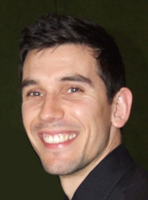ANAT2341 Lab 4: Difference between revisions
mNo edit summary |
No edit summary |
||
| Line 1: | Line 1: | ||
{{ANAT2341Lab4}} | {{ANAT2341Lab4}} | ||
= | =Endoderm Development= | ||
== 1. QUIZ == | |||
== | ==2. Guest Lecturer Dr. Nicolas Fossat (CMRI) - Endoderm, RNA biology and gut organoids == | ||
[[File:Nicolas_Fossat_profile_photo.jpg]] | |||
Doctor Nicolas Fossat is a Research Fellow in Professor Patrick Tam’s laboratory, in the Embryology Unit, Children’s Medical Research Institute. | |||
Dr Fossat completed his PhD in 2005 at the Ecole Normale Superieure of Lyon in France. During this period, he studied the homeodomain transcription factor Otx2 which is coded by one of the few master genes essential for the formation of the head. Notably, using the latest tools of molecular biology, he developed a novel genetic approach called “conditional self-knockout” allowing the inactivation of the Otx2 gene at anytime and anywhere in the mouse. His background is a strong understanding of and an easy ability to manipulate the mouse embryo genome. In 2007, he joined Professor Patrick Tam’s team. Professor Tam is a pioneer in mouse embryo manipulation. In his lab, he pursues his understanding of the formation of the head. He focuses on the intersection of transcriptional and signalling activities by studying the interaction of another important actor of the formation of the head, the master gene Lhx1, and a fundamental pathway, the WNT signalling pathway which is crucial in every part of the body for the control of cell proliferation and cell differentiation. In addition, he works on the foregut endoderm which is also important for the formation of the head as well as for the establishment of organs involved in secretory or absorptive functions, such as the thyroid, pancreas and the liver. With the ultimate goal to cure diseases affecting these organs such as hypo/hyper-thyroidism or diabetes, he has started to study the function of an unknown gene that Patrick Tam’s lab has identified as specifically active in the foregut endoderm. This new gene codes a RNA-binding protein which has led me to also take a great interest in RNA and miRNA functions. | |||
==References== | |||
{{2016ANAT2341 footer}} | {{2016ANAT2341 footer}} | ||
Revision as of 10:32, 13 December 2016
| ANAT2341 Lab 4: Introduction | Implantation and Villi | Decidua and Cord | Abnormal Placenta | Cardiovascular | Online Assessment | Group Project |
Endoderm Development
1. QUIZ
2. Guest Lecturer Dr. Nicolas Fossat (CMRI) - Endoderm, RNA biology and gut organoids
Doctor Nicolas Fossat is a Research Fellow in Professor Patrick Tam’s laboratory, in the Embryology Unit, Children’s Medical Research Institute.
Dr Fossat completed his PhD in 2005 at the Ecole Normale Superieure of Lyon in France. During this period, he studied the homeodomain transcription factor Otx2 which is coded by one of the few master genes essential for the formation of the head. Notably, using the latest tools of molecular biology, he developed a novel genetic approach called “conditional self-knockout” allowing the inactivation of the Otx2 gene at anytime and anywhere in the mouse. His background is a strong understanding of and an easy ability to manipulate the mouse embryo genome. In 2007, he joined Professor Patrick Tam’s team. Professor Tam is a pioneer in mouse embryo manipulation. In his lab, he pursues his understanding of the formation of the head. He focuses on the intersection of transcriptional and signalling activities by studying the interaction of another important actor of the formation of the head, the master gene Lhx1, and a fundamental pathway, the WNT signalling pathway which is crucial in every part of the body for the control of cell proliferation and cell differentiation. In addition, he works on the foregut endoderm which is also important for the formation of the head as well as for the establishment of organs involved in secretory or absorptive functions, such as the thyroid, pancreas and the liver. With the ultimate goal to cure diseases affecting these organs such as hypo/hyper-thyroidism or diabetes, he has started to study the function of an unknown gene that Patrick Tam’s lab has identified as specifically active in the foregut endoderm. This new gene codes a RNA-binding protein which has led me to also take a great interest in RNA and miRNA functions.
References
Glossary Links
- Glossary: A | B | C | D | E | F | G | H | I | J | K | L | M | N | O | P | Q | R | S | T | U | V | W | X | Y | Z | Numbers | Symbols | Term Link
Cite this page: Hill, M.A. (2024, May 17) Embryology ANAT2341 Lab 4. Retrieved from https://embryology.med.unsw.edu.au/embryology/index.php/ANAT2341_Lab_4
- © Dr Mark Hill 2024, UNSW Embryology ISBN: 978 0 7334 2609 4 - UNSW CRICOS Provider Code No. 00098G
